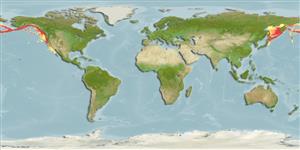Environment: milieu / climate zone / depth range / distribution range
Écologie
marin bathydémersal; océanodrome (Ref. 51243); profondeur 175 - 2740 m (Ref. 6793), usually 175 - 1450 m (Ref. 10935). Deep-water; 64°N - 23°N, 141°E - 109°W
North Pacific: Bering Sea coasts of Kamchatka, Russia and Alaska southward to Hatsu Shima Island, southern Japan and Cedros Island, central Baja California, Mexico in the eastern Pacific.
Length at first maturity / Taille / Poids / Âge
Maturity: Lm 60.3, range 58 - 62 cm
Max length : 120 cm TL mâle / non sexé; (Ref. 9988); common length : 80.0 cm TL mâle / non sexé; (Ref. 9988); âge max. reporté: 94 années (Ref. 55701)
Description synthétique
Clés d'identification | Morphologie | Morphométrie
Épines dorsales (Total) : 19 - 27; Rayons mous dorsaux (Total) : 16 - 20; Épines anales: 3; Rayons mous anaux: 15 - 19. Dorsal fins well separated; 2nd dorsal fin sub equal to anal fin in size and form, and opposite in position. Reaches over 1 m in SL.
Adults found on mud bottoms, from 305 (Ref. 2850) to 2,740 m depth (Ref. 2850). Young-of-the-year juveniles are pelagic and found on the surface and near-shore waters (Ref. 28499). Generally localized, but some juveniles have been found to migrate over 2,000 miles in 6 or 7 years (Ref. 28499). Feed on crustaceans, worms and small fishes (Ref. 4925). Most of the catch is marketed in Japan (Ref. 28499). Utilized fresh, dried or salted and smoked (Ref. 9988), can be steamed, pan-fried, broiled, boiled, microwaved and baked (Ref. 9988). The liver oil is rich in vitamin A and D (Ref. 4925). Reported to reach 57 kg in Ref. 2850.
Eschmeyer, W.N., E.S. Herald and H. Hammann, 1983. A field guide to Pacific coast fishes of North America. Boston (MA, USA): Houghton Mifflin Company. xii+336 p. (Ref. 2850)
Statut dans la liste rouge de l'IUCN (Ref. 130435: Version 2024-2)
Menace pour l'homme
Harmless
Utilisations par l'homme
Pêcheries: hautement commercial; Aquaculture: probable utilisation future; pêche sportive: oui; Aquarium: Aquariums publics
Outils
Articles particuliers
Télécharger en XML
Sources Internet
Estimates based on models
Preferred temperature (Ref.
123201): 1.4 - 5.5, mean 2.5 °C (based on 599 cells).
Phylogenetic diversity index (Ref.
82804): PD
50 = 1.2500 [Uniqueness, from 0.5 = low to 2.0 = high].
Bayesian length-weight: a=0.01122 (0.00806 - 0.01563), b=2.98 (2.88 - 3.08), in cm total length, based on LWR estimates for this species (Ref.
93245).
Niveau trophique (Ref.
69278): 3.8 ±0.2 se; based on diet studies.
Generation time: 5.8 (4.9 - 7.8) years. Estimated as median ln(3)/K based on 23
growth studies.
Résilience (Ref.
120179): Très faible, temps minimum de doublement de population supérieur à 14 ans (K=0.2; tm=6; Fec=100,000; tmax=94).
Prior r = 0.11, 95% CL = 0.07 - 0.16, Based on 10 full stock assessments.
Fishing Vulnerability (Ref.
59153): Moderate to high vulnerability (49 of 100).
Climate Vulnerability (Ref.
125649): High vulnerability (58 of 100).
Nutrients (Ref.
124155): Calcium = 16.1 [9.1, 38.6] mg/100g; Iron = 0.46 [0.23, 0.90] mg/100g; Protein = 17 [16, 18] %; Omega3 = 0.567 [0.254, 1.631] g/100g; Selenium = 32.5 [14.5, 79.2] μg/100g; VitaminA = 8.27 [1.99, 36.01] μg/100g; Zinc = 0.27 [0.18, 0.42] mg/100g (wet weight);
